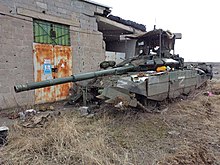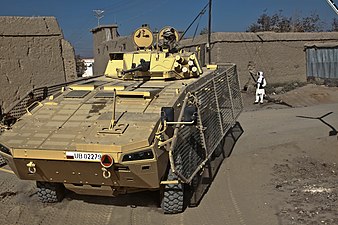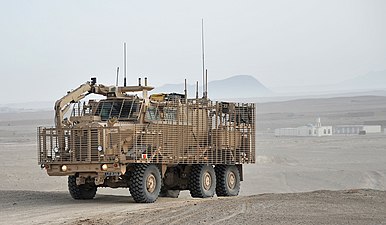슬랫갑
Slat armor
슬래트 갑옷(, )은 대전차 유도탄(ATGM) 및 로켓 추진 수류탄(RPG)에 사용되는 고성능 대전차(HEAT) 공격으로부터 보호하기 위해 설계된 차량용 갑옷의 한 종류입니다.
작동
슬랫 갑옷은 차량의 주요 부분에 장착된 단단한 슬랫 금속 격자 형태를 취하는데, 이는 탄두를 분쇄하여 최적의 폭발이 일어나지 않도록 하거나, 푸징 메커니즘을 손상시켜 노골적인 폭발을 방지함으로써 탄두의 형태를 방해합니다.슬랫 방어구는 미사일이 들어오는 것에 효과적이지만, 완벽한 방어 기능을 제공하지는 못합니다. 슬랫 설계로 인해 미사일 충격의 50%가 방해받지 않습니다.[1]슬랫 방어구는 케이지 간격이 들어오는 RPG 라운드의 직경(일반적으로 85mm)보다 작으면 효과가 더 높을 가능성이 있습니다.[2]
전투이력
제2차 세계 대전

독일 국방군은 제2차 세계 대전 당시 포탄 사격에 대비해 전차를 강화하기 위해 Drahtgeflecht-Sürzen(영어: "와이어 메쉬 스커트")을 사용한 최초의 철조갑옷의 사용자였습니다.[3]철판 쉬르젠을 사용한 것과 마찬가지로 효과가 있는 것으로 나타났습니다.1943년 3월, 아돌프 히틀러는 신형 슈투름게슈츠, 3호 전차, 4호 전차, 4호 전차에 철망 또는 철판형 슈바르젠을 장착하도록 명령했습니다.그러나 철망은 철판 쉬르젠이나 장갑 치마처럼 대량생산이 쉽지 않았습니다.소련의 붉은 군대 전차들은 새롭고 효과적인 독일의 기갑군에 맞섰고, 마찬가지로 확장된 금속 망사 격자 패널로 만든 "침대 스프링" 장갑을 장착했습니다.
그러나, 슈어젠은 소련의 PTRD-41 대전차 소총을 막기 위해 설계되었고, 미국과 독일의 시험에서 바주카와 판저슈렉 대전차 로켓에 대해 효과가 없다는 것이 증명되었습니다.[4]
냉전시대

베트남 전쟁에서, 슬래트 갑옷은 미국의 순찰용 바지선과 배의 측면에 일반적으로 사용되었습니다.CCB-18은 그러한 갑옷을 사용한 모빌 리버린 포스의 현존하는 예입니다.[5]M113과 같은 차량에 와이어 펜싱을 설치하여 비엣콩 RPG를 격파하기도 했습니다.같은 시대의 스웨덴 Stridsvagn 103호는 날아오는 발사체로부터 보호하기 위해 훨씬 더 무거운 전면 장착 금속 그리드를 사용했습니다.
근세
현대에 와서는 이스라엘 방위군의 캐터필러 D9R 장갑 불도저, 버팔로 MPV MRAP 차량, 제너럴 다이내믹스 스트라이커, 우크라이나 BTR-4, 워리어 보병 전투 [6]차량, M113 APC, 브리티시 챌린저 2,[7] 레오파드 2A6 주력 전차, 러시아 T-62 전차에 슬랫 갑옷이 사용되었습니다.[8]슬랫 갑옷은 형상화된 탄두에 대한 효과뿐만 아니라 훨씬 가벼운 무게로 인해 기존의 판 갑옷보다 선호되며, 이는 차량 기동성을 향상시킵니다.[9]
슬랫 갑옷은 2005년 이스라엘 IDF 캐터필러 D9R 장갑 불도저에 처음 사용되었으며, 2006년에 대량으로 설치되었습니다.비슷한 시기인 2005년에 육군연구소(ARL), 개발시험사령부, 애버딘시험센터(ATC)의 전문가 팀이 RPG로부터 차량을 보호하기 위해 처음으로 슬랫 갑옷을 Stryker에 제안했습니다.[10]ARL과 ATC는 7일 이내에 최초의 프로토타입을 설계 및 제작하였으며, 이후 오하이오의 리마 육군 탱크 공장에서 대량 생산되어 Stryker의 다양한 변형으로 구현되었습니다.슬래트 갑옷의 디자인은 차량 주변에 50cm 전방에 케이지를 배치하여 RPG 탄두가 안전한 거리에서 폭발할 수 있도록 했습니다.[2]또한 Stryker 차량의 슬랫 갑옷은 HEAT 라운드에 효과적이라고 합니다.
2007년에 BAE Systems는 LROD라는 이름의 매우 가벼운 알루미늄 슬랫 갑옷 시스템을 개발했는데, 이 시스템은 처음에 버팔로 MPV에 사용되었고, 동급의 강철 디자인의 절반 무게라고 주장되었습니다.[6]이후 BAE는 여러 대의 미군 RG-31에 LROD 시스템을 장착하고, RG-33 차량인 카이만과 JERRV를 위한 시스템을 개발했습니다.슬랫 갑옷은 TUSK(Tank Urban Survival Kit) 도시전 시리즈의 일환으로 미국 M1 에이브럼스에 장착되기도 합니다.시리아 내전과 이슬람국가 이라크·레반트(ISIS), 자유시리아군과 시리아군은 RPG 충격으로부터 장갑차를 보호하기 위해 사제 슬랫갑옷을 장착했습니다.
러시아는 2016년 8월 NII Stali와 Uralvagonzavod가 개발한 바슬랫 갑옷을 도입하여 RPG와 무반동 소총 HEAT 라운드에 대한 러시아 장갑차의 방호력을 55~60% 증가시켰습니다.방탄복은 BTR-50, BTR-60, BTR-70, BTR-80/82, BTR-90, BMP-1, BMP-2, BMP-3, BRDM-2, BRDM-3, T-14 아르마타 등 구소련 및 러시아의 다양한 차량과 통합할 수 있으며, 풀 키트에는 1,000 kg의 무게가 추가됩니다.[11]
탑마운팅

2021년에는 강철 그릴로 만든 탑 마운트 즉흥 슬랫 갑옷으로 다양한 러시아 전차가 관찰되었는데, 이는 코지레콧 솔트사(러시아어: козырек от солнца, 불이 켜짐)라는 별명으로 불렸습니다.2021년 중반,[13][14] 러시아 국방부는 "다양한 무기"에 대한 보호를 강화하기 위한 것이라고 밝혔습니다.[14]2021년 12월, 우크라이나 육군은 T-64와 같은 포탑을 장착한 장갑 전투 차량이 창던 미사일에 의해 파괴된 군사 훈련 영상을 공개했습니다.[15]이러한 구현은 탱크에 무게를 더하고, 시각적 윤곽을 증가시키며, 승무원이 차량에 출입하는 것을 더욱 어렵게 만듭니다.[16]2022년 러시아가 우크라이나를 침공했을 때, 그들은 영어 온라인 커뮤니티, 서부 군사 분석가 및 영국 국방 장관 벤 월리스에 의해 "커버 케이지(cope cages)"[17]라고 경멸적으로 명명되었으며,[18] 갑옷이 w라는 분석가들의 가정에 기초하여 실제 효과에 대해 회의적인 의견을 나타냈습니다.FGM-148 창과 같은 하향식 대전차 미사일 및 기타 공격용 군수품의 위협을 완화하기 위해 설계되었을 가능성이 가장 높습니다.[19]
다른 분석가들은 2020년 나고르노-카라바흐 전쟁과[20] 제1차 체첸 전쟁에서 얻은 교훈에 대한 대응으로 도시 전투, 어슬렁거리는 군수품 또는 드론 공격에 대한 RPG-7과 같은 무기의 HEAT 탄두에 대한 대책으로 대신 사용될 수 있다고 제안했습니다.[21]서로 다른 메쉬와 철책으로 만들어진 임시 케이지 변형 사이에 균일성이 부족하다는 것은 탱크 승무원들에 의해 주로 즉흥적으로 만들어졌다는 것을 의미하며, 표준적인 문제는 아닙니다.[22][23]2022년 5월, 우크라이나에서 귀국한 일부 러시아 유조선과의 러시아 언론 인터뷰에서 소속 선원들이 기관총과 무전기 사용을 방해해 결국 우리를 제거하고, 탱크에 불이 붙으면 적기 대피를 막았다고 보도했습니다.[24]2023년 여름까지 2023년 우크라이나 반격에 참여하는 여러 우크라이나 전차들이 챌린저 2호를 포함한 다양한 지붕 가림막과 함께 발견되었지만, 대부분은 슬랫 갑옷을 사용하는 대신 그물을 재료로 사용했습니다.[25][26]
갤러리
-
2008년 개량형 M113 장갑차 슬랫갑갑옷
-
M1 에이브럼스 선체 후면의 엔진 배기구를 보호하는 슬랫 갑옷
-
아프가니스탄의 폴란드 KTO Rosomak에 장착된 라이터 네트 타입, 2010
-
2012년 WARTHOG ATTC에 장착된 슬래트 갑옷
-
IDF 캐터필러 D9 장갑 불도저의 슬랫 갑옷
-
59G 더조이 전차의 포탑 후면을 보호하는 슬랫 갑옷
-
아프가니스탄에서 슬랫 갑옷을 부착한 버팔로 차량
참고 항목
참고문헌
- ^ "BAE의 LROD 케이지 아머."방위산업일보. 2012년 8월 17일.2015년 2월 13일 회수.
- ^ a b Yap, Chun (September 2012). "The Impact of Armor on the Design, Utilization and Survivability of Ground Vehicles: The History of Armor Development and Use". Naval Postgraduate School. Archived from the original on June 11, 2017 – via Defense Technical Information Center.
- ^ "스투름게슈체보르!"StugIII.com .2013년 2월 12일 회수.Wayback Machine에서 2013년 12월 8일 보관
- ^ 바주카 대 기갑, 1944년 벌지 전투, 스티븐 J. 잘로가, 오스프리, p. 34, 38
- ^ CCB 메모리얼 펀드 웨이백 머신에서 2014-10-06 보관.MRFA.org .2013년 2월 12일 회수.
- ^ a b "MRAP 케이지 파이트".DefenseTech.org . 2007년 7월 18일.2012년 10월 4일 회수.
- ^ "Background — CF 임대 및 구입 레오파드 2 A6M / 2 A4 탱크" Wayback Machine에서 2008-04-16 보관.CASR. 2013년 2월 12일 회수.
- ^ "2008년 8월 15일 남오세티야 인근 고리에서 한 러시아 군인이 T-62 탱크 옆에서 읽고 있습니다."Flickr을 통한 로이터 통신.2012년 4월 1일 회수.
- ^ "스트라이커를 위한 슬래트 아머".Defense-Update.com .2005년. 2013년 2월 12일 회수.
- ^ Rooney, John (January 2007). "Armor Testing, An Example of T&E for Rapid Acquisitions". ITEA Journal: 4–6. Archived from the original on March 10, 2021 – via Defense Technical Information Center.
- ^ 러시아, 전투 차량 보호를 위한 바슬랫 갑옷 개발 - Armyrecognition.com , 2016년 8월 19일
- ^ Roblin, Sebastien. "Russian Tanks Massing Near Ukraine Sport Mods Against Drones, Javelin Missiles". Forbes. Archived from the original on 2022-03-11. Retrieved 2022-03-11.
- ^ "Противоракетный "козырек": Т-72Б3 с новой защитой замечен под Ростовом". Rossiyskaya Gazeta (in Russian). June 18, 2021. Archived from the original on June 18, 2021.
Новое защитное устройство, установленное в верхней части башни, внешне напоминает навес, за что получило среди танкистов неофициальное название - "козырек от солнца".
[The new protective device, installed on the upper portion of the turret, appears similar to a canopy, earning it the unofficial name "sun visor" among tankers.] - ^ a b "На российские танки начали устанавливать импровизированную защиту от Javelin и БПЛА". Новости ВПК (in Russian). July 7, 2021. Archived from the original on April 5, 2022.
Защитное устройство в верхней части башни получило неофициальное прозвище «козырек от солнца». В Минобороны сообщили, что оно предназначено для усиления защиты от разных средств поражения... В военном ведомстве не рассказали о принципе действия защиты, однако отметили, что другие Т-72 тоже получат «козырек».
[The protective device at the top of the turret was given the informal nickname "sun visor". The Ministry of Defense reported that it is intended to enhance protection against various weapons... the military department did not talk about the specifics of the protection, but noted that other T-72s would also have the "visor" installed.] - ^ Thomas Newdick (23 December 2021). "Ukrainian Troops Test Javelin Missile Against Russian Cage-Style Improvised Tank Armor". The Drive. Brookline Media Inc.
- ^ Alia Shoaib (March 26, 2022). "Russian soldiers appear to be fixing makeshift cages to the turrets of their tanks in a crude effort to protect themselves against Ukraine's anti-tank missiles". Business Insider. Archived from the original on March 26, 2022.
"The advantage Russian tanks have is that they're super small and very low, making them easy to hide. When you start doubling the height, you're getting rid of some of the advantages of the vehicle," Crump said. The cages also make it harder for the crew to get in and out of the vehicles, according to Crump.
- ^
- "Russian tanks in Ukraine are sprouting cages". The Economist. March 14, 2022. Archived from the original on March 16, 2022.
They have indeed been mockingly dubbed by Western analysts as 'emotional support armour' or 'cope cages'. Superficially, they are an example of what is known in military circles as field-expedient armour—in other words, stuff that has been added to vehicles after they have entered service.
- "Igazi tankszörnyet zsákmányoltak az ukránok". Portfolio.hu (in Hungarian). March 2, 2022. Archived from the original on March 15, 2022.
Érdekes egy szót említeni a „kutyaólként" vagy "csirkeketrecként," angolszász forrásokban „cope cage," vagyis durván „dolgozd fel ketrecként" emlegetett improvizált páncélzatról a tornyon. A páncélzat célja az lenne, hogy megvédje a harcjárműveket a felülről érkező drónrakétáktól vagy páncéltörő rakétáktól.
[It is interesting to mention the terminology surrounding the improvised armour on the tower, referred to as 'dog kennel' or 'chicken coop' in Hungarian, or 'cope cage' in Anglo-Saxon sources. The purpose of the armor would be to protect the combat vehicles from drone missiles or armor-piercing rockets coming from above.] - James Dwyer (March 10, 2022). "How do anti-tank missiles work, and how helpful might they be for Ukraine's soldiers?". Australian Broadcasting Corporation. Archived from the original on March 15, 2022.
These are colloquially termed 'cope cages' by various communities on the internet. Of course, they will do little to minimise the impact from a missile, but they do demonstrate that Russian soldiers are fearful of the threat the missiles present.
- "What to know about the role Javelin antitank missiles could play in Ukraine's fight against Russia". Washington Post. March 12, 2022. Archived from the original on March 12, 2022.
Social media has been littered with photos of destroyed Russian tanks with cages. The images have acquired a symbolic resonance so quickly that Internet users have coined the term 'cope cage' earning a page on the Internet's primary meme directory.
- "Russian tanks in Ukraine are sprouting cages". The Economist. March 14, 2022. Archived from the original on March 16, 2022.
- ^ "Speech by Defence Secretary on Russia's invasion of Ukraine". gov.uk. 9 May 2022. Archived from the original on May 9, 2022. Retrieved 2022-05-09.
Russian soldiers' futile use of pine logs as makeshift protection on logistical trucks and attaching overhead 'cope cages' to their tanks, it's nothing short of tragic. But their commanders' failures to adapt before entering them into such a conflict is criminal.
- ^
- "Russian tanks in Ukraine are sprouting cages". The Economist. March 14, 2022. Archived from the original on March 16, 2022.
They appear to be oriented in a way that protects only against attacks from above. In principle, that might help against Javelins, which have a 'top attack' mode ... [but] even if the cage sets off a Javelin's precursor warhead, the main charge is still more than powerful enough to punch through the top armour and destroy the tank
- Alia Shoaib (March 26, 2022). "Russian soldiers appear to be fixing makeshift cages to the turrets of their tanks in a crude effort to protect themselves against Ukraine's anti-tank missiles". Business Insider. Archived from the original on March 26, 2022.
"The cages are supposed to defend against anti-tank weapons that strike the top of the vehicle, where the armor is the thinnest. "The idea is that if you set off a bazooka or a Panzerfaust... they're set off early and so they don't hit the tank itself..." Crump explained. However, the cages are largely ineffective against the modern anti-tank weapons used by the Ukrainians, such as the Javelin and NLAW... Many modern weapons are designed to counter that sort of protection
- "Russian tanks in Ukraine are sprouting cages". The Economist. March 14, 2022. Archived from the original on March 16, 2022.
- ^
- "Russian tanks in Ukraine are sprouting cages". The Economist. March 14, 2022. Archived from the original on March 16, 2022.
Another idea is that the cages are a response to the conflict in 2020 between Armenia and Azerbaijan, over Nagorno-Karabakh, in which large numbers of Russian-made Armenian tanks were destroyed from above by MAM-Ls ... A third possibility is that the cages are meant as protection against RPGs ... which are being fired at tanks from above. This ... is a preferred tactic in urban warfare, where buildings offer shooters the necessary elevation.
- "Les «cope cages», protections bricolées et moquées des chars russes impuissants". Slate.fr (in French). March 23, 2022. Archived from the original on March 23, 2022.
Ces structures approximatives sont ce qu'il est devenu coutumier d'appeler des cope cages en anglais –des «cages pour faire avec», pour traduire grossièrement l'expression. Elles sont le résultat des observations par l'armée russe du conflit opposant Azerbaïdjan et Arménie dans le Haut-Karabakh.
[It has become customary to call these makeshift structures "cope cages" in English, an expression which roughly translates to "cages pour faire avec". They are the result of observations made by the Russian army towards the conflict between Azerbaijan and Armenia in Nagorno-Karabakh.] - Newdick, Thomas (24 November 2021). "Russian T-80 Tank With Improvised Anti-Drone Armor Reportedly Appears In Crimea". The Drive. Archived from the original on 24 February 2022. Retrieved 2022-03-11.
- "Russian tanks in Ukraine are sprouting cages". The Economist. March 14, 2022. Archived from the original on March 16, 2022.
- ^ Robert Tollast (April 7, 2022). "How Javelin missiles penetrate Russian tank cage armour". The National. Archived from the original on April 8, 2022.
...the Russians might have had another defence in mind, possibly drones with small missile warheads attacking from above, or RPGs being fired from rooftops in urban battles, a problem Russia encountered in Chechnya.
- ^ Alia Shoaib (March 26, 2022). "Russian soldiers appear to be fixing makeshift cages to the turrets of their tanks in a crude effort to protect themselves against Ukraine's anti-tank missiles". Business Insider. Archived from the original on March 26, 2022.
The lack of uniformity of the cages, and the fact that they are only seen on some tanks, shows that Russian units are largely improvising them
- ^ Robert Tollast (April 7, 2022). "How Javelin missiles penetrate Russian tank cage armour". The National. Archived from the original on April 8, 2022.
...even in cases where the slat armour could be useful, perhaps against small "kamikaze drones" or small munitions fired or dropped from drones, the DIY nature of the Russian cages could still be a fatal flaw. Quality engineering "does not apply to the 'cope cage'... The 'grill' appears to be less dense than proper cage armour and constructed from random household materials in some cases."
- ^ Sergei Valchenko (May 24, 2022). "Танкист-герой рассказал о спецоперации и погиб: «Победим, но легко не будет»". Moskovskij Komsomolets (in Russian). Archived from the original on May 24, 2022.
Обвесы (металлические решетки для защиты от противотанковых ракет) мы сначала все наварили на танки, а потом их все сняли. Во-первых, неудобно: пулемет не двигается, антенна когда замыкает об решетку – сгорает радиостанция, связь пропадает. И если будет какое-то возгорание, там просто нереально будет вылезти из танка... Поэтому их все сняли и выкинули.
[At first we welded the body kits (metal grilles for protection against anti-tank missiles) to the tanks, but then they were all removed. Firstly, it is inconvenient: the machine gun is unable to move, and the radio connection disappears when the antenna touches the grille. If there is some kind of fire, it will be simply unrealistic to get out of the tank... So they were all removed and thrown away.] - ^ "Ukrainian T-72M1 with roof screen".
- ^ "Challenger 2 Also Uses a Cope Cage".









